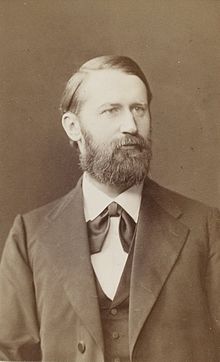This article includes a list of general references, but it lacks sufficient corresponding inline citations. (April 2011) |
Arthur Auwers | |
|---|---|
 Arthur Auwers in 1884 | |
| Born | 12 September 1838 |
| Died | 24 January 1915 (aged 76) |
| Nationality | German |
| Scientific career | |
| Fields | Astronomy |
Georg Friedrich Julius Arthur von Auwers (12 September 1838 – 24 January 1915) was a German astronomer. Auwers was born in Göttingen to Gottfried Daniel Auwers and Emma Christiane Sophie (née Borkenstein).[1]
He attended the University of Göttingen and worked at the University of Königsberg. He specialized in astrometry, making very precise measurements of stellar positions and motions. He detected the companion stars of Sirius and Procyon from their effects on the main star's motion, before telescopes were powerful enough to visually observe them. He was from 1866 Secretary to the Berlin Academy, and directed expeditions to measure the transits of Venus, in order to measure the distance from the earth to the Sun more accurately, and therefore be able to calculate the dimensions of the Solar System more accurately and with greater precision. He began a project to unify all available sky charts, an interest that began with his catalog of nebulae which he published in 1862. He died in Berlin. His grave is preserved in the Protestant Friedhof I der Jerusalems- und Neuen Kirchengemeinde (Cemetery No. I of the congregations of Jerusalem's Church and New Church) in Berlin-Kreuzberg, south of Hallesches Tor.
His son Karl von Auwers became a well known chemist and discoverer of the Auwers synthesis.
- ^ Hockey, Thomas (2009). The Biographical Encyclopedia of Astronomers. Springer Publishing. ISBN 978-0-387-31022-0. Retrieved August 22, 2012.